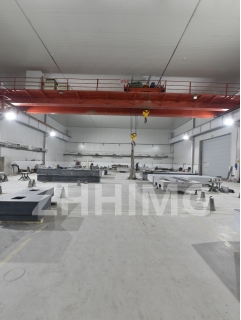In the field of precision manufacturing and quality inspection, the three-coordinate measuring machine is the core equipment for ensuring product accuracy. The accuracy of its measurement data directly affects product quality and the optimization of production processes. However, the thermal deformation error caused by temperature changes during the operation of the equipment has always been a difficult problem plaguing the industry. The granite base, with its outstanding physical properties and structural advantages, has become the key to eliminating the thermal deformation error of the three-coordinate measuring machine.

The causes and hazards of thermal deformation errors in three-coordinate measuring machines
When a three-coordinate measuring machine is in operation, the motor running, friction generating heat, and fluctuations in environmental temperature can all cause changes in the equipment's temperature. The base of the measuring machine made of traditional metal materials has a relatively high coefficient of thermal expansion. For instance, the coefficient of thermal expansion of ordinary steel is approximately 11×10⁻⁶/℃. When the temperature rises by 10℃, the 1-meter-long metal base will elongate by 110μm. This slight deformation will be transmitted to the measuring probe through the mechanical structure, causing the measurement position to shift and ultimately resulting in errors in the measurement data. In the inspection of precision parts, such as aero engine blades and precision molds, an error of 0.01mm can lead to product nonconformity. Thermal deformation errors seriously affect the reliability of measurement and production efficiency.
The characteristic advantages of granite bases
Ultra-low coefficient of thermal expansion, stable measurement reference
Granite is a natural igneous rock formed through geological processes over hundreds of millions of years. Its coefficient of thermal expansion is extremely low, typically ranging from (4-8) ×10⁻⁶/℃, which is only 1/3 to 1/2 of that of metallic materials. This means that under the same temperature variation, the size change of the granite base is extremely small. When the ambient temperature fluctuates, the granite base can maintain a stable geometric shape, providing a solid reference for the coordinate system of the measuring machine, avoiding the position deviation of the measuring probe caused by the deformation of the base, and reducing the impact of thermal deformation errors on the measurement results from the root.
High rigidity and uniform structure suppress deformation transmission
Granite is hard in texture, with a dense and uniform internal mineral crystal structure, and its hardness can reach 6-7 on the Mohs scale. This high rigidity makes the granite base less likely to undergo elastic deformation when bearing the weight of the measuring machine itself and external forces during the measurement process. Even when the equipment operation generates slight vibrations or local uneven forces, the granite base can effectively suppress the transmission and spread of deformation with its uniform structural characteristics, prevent deformation from being conducted from the base to the measuring mechanism, ensure that the measuring probe is always in a stable working state, and guarantee the accuracy of the measurement data.
Natural damping performance, absorbing vibration and heat
The unique microstructure of granite endows it with excellent damping performance. When the vibration generated by the operation of the measuring machine is transmitted to the granite base, the internal mineral particles and tiny pores can convert the vibration energy into heat energy and consume it, rapidly attenuating the vibration amplitude. Meanwhile, this damping characteristic also helps to absorb the heat generated by the operation of the equipment, slow down the accumulation and diffusion rate of temperature on the base, and reduce the risk of local thermal deformation caused by uneven temperature distribution. In continuous long-term measurement operations, the damping performance of the granite base can significantly reduce the occurrence of thermal deformation errors and enhance measurement stability.
The practical application effect of the granite base
After many manufacturing enterprises replaced the metal base of the three-coordinate measuring machine with a granite base, the measurement accuracy was significantly improved. After a certain auto parts manufacturing enterprise introduced a three-coordinate measuring machine equipped with a granite base, the measurement error for the engine block was reduced from the original ±15μm to within ±5μm. The repeatability and reproducibility of the measurement data were significantly improved, the reliability of product quality inspection was enhanced, and the product misjudgment rate caused by measurement errors was effectively reduced. It has improved production efficiency and the competitiveness of enterprises.
In conclusion, the granite base, with its extremely low coefficient of thermal expansion, high rigidity, uniform structure and excellent damping performance, eliminates the thermal deformation error of the three-coordinate measuring machine from multiple dimensions, providing a stable and reliable basic support for precise measurement, and has become an indispensable key component of modern high-precision measuring equipment.
Post time: May-19-2025

